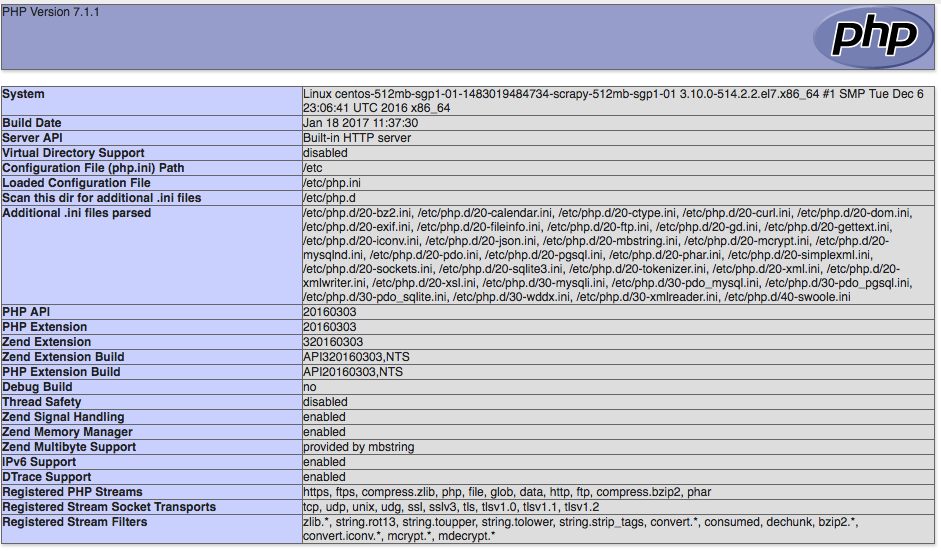Centos Install Php As Apache Module Api
PHP-FPM does have some advantages depending on the solution and the common path is to use Nginx with PHP-FPM. Driver Hp Photosmart C5380 All-in-one Windows 7. However what happens when you want to utilize the normal features of Apache, such as basics like. Phpmaker Tutorial Pdf there. Contoh Program Kasir Dengan Php Array Index here. htaccess files, but still keep the tuning options open that come with PHP-FPM?
Well, there is a module for that! This guide is going to assume a fresh CentOS 7 server to illustrate everything from start to finish, and will assume that all sites on this server will use the same php-fpm pool. First, installed the required packages for your web server: [ ~]# yum install httpd httpd-tools mod_ssl php-fpm Now update the Apache configuration to use the mpm_event_module instead of the mpm_prefork_module: [ ~]# vim /etc/httpd/conf.modules.d/00-mpm.conf # LoadModule mpm_prefork_module modules/mod_mpm_prefork.so LoadModule mpm_worker_module modules/mod_mpm_worker.so Then tell Apache to send all PHP requests over to PHP-FPM by creating a new configuration file: [ ~]# vim /etc/httpd/conf.d/php.conf # Tell the PHP interpreter to handle files with a.php extension. # Proxy declaration # we must declare a parameter in here (doesn't matter which) or it'll not register the proxy ahead of time ProxySet disablereuse=off # Redirect to the proxy SetHandler proxy:fcgi://php-fpm # # Allow php to handle Multiviews # AddType text/html.php # # Add index. The Art Of Choosing Iyengar Pdf Printer. php to the list of files that will be served as directory # indexes. # DirectoryIndex index.php # # Uncomment the following lines to allow PHP to pretty-print.phps # files as PHP source code: # # # SetHandler application/x-httpd-php-source # Tweak PHP-FPM to use sockets instead of TCP connections for performance purposes as follows: [ ~]# vim /etc/php-fpm.d/www.conf; listen = 127.0.0.1:9000 listen = /var/run/php-fpm/default.sock. Listen.allowed_clients = 127.0.0.1 listen.owner = apache listen.group = apache listen.mode = 0660 user = apache group = apache And lastly, enable the services to start on boot and start them up: [ ~]# systemctl enable php-fpm [ ~]# systemctl enable httpd [ ~]# systemctl start php-fpm [ ~]# systemctl start httpd If you are using a software firewall on the server, open ports 80/443 accordingly.
This example will open them up to the world. Adjust yours accordingly: [ ~]# firewall-cmd --zone=public --permanent --add-service=http [ ~]# firewall-cmd --zone=public --permanent --add-service=https [ ~]# firewall-cmd --reload Finally, test a site to ensure PHP is working and is using PHP-FPM by creating the file below, then visiting the page at x.x.x.x/info.php: [ ~]# vim /var/www/html/info.php And your done! Using multiple PHP-FPM pools What happens if you want to isolate each site to their own PHP-FPM pool instead of using a shared pool? That is easy enough to do. Assuming that you followed everything in this guide to get to this point, do the following. First, disable the global Apache configuration for PHP: [ ~]# mv /etc/httpd/conf.d/php.conf /etc/httpd/conf.d/php.conf.bak Create a new PHP-FPM pool for this specific site and update it accordingly: [ ~]# cp /etc/php-fpm.d/www.conf /etc/php-fpm.d/example.com.conf [ ~]# vim /etc/php-fpm.d/example.com.conf; listen = 127.0.0.1:9000 listen = /var/run/php-fpm/example.com.sock.
